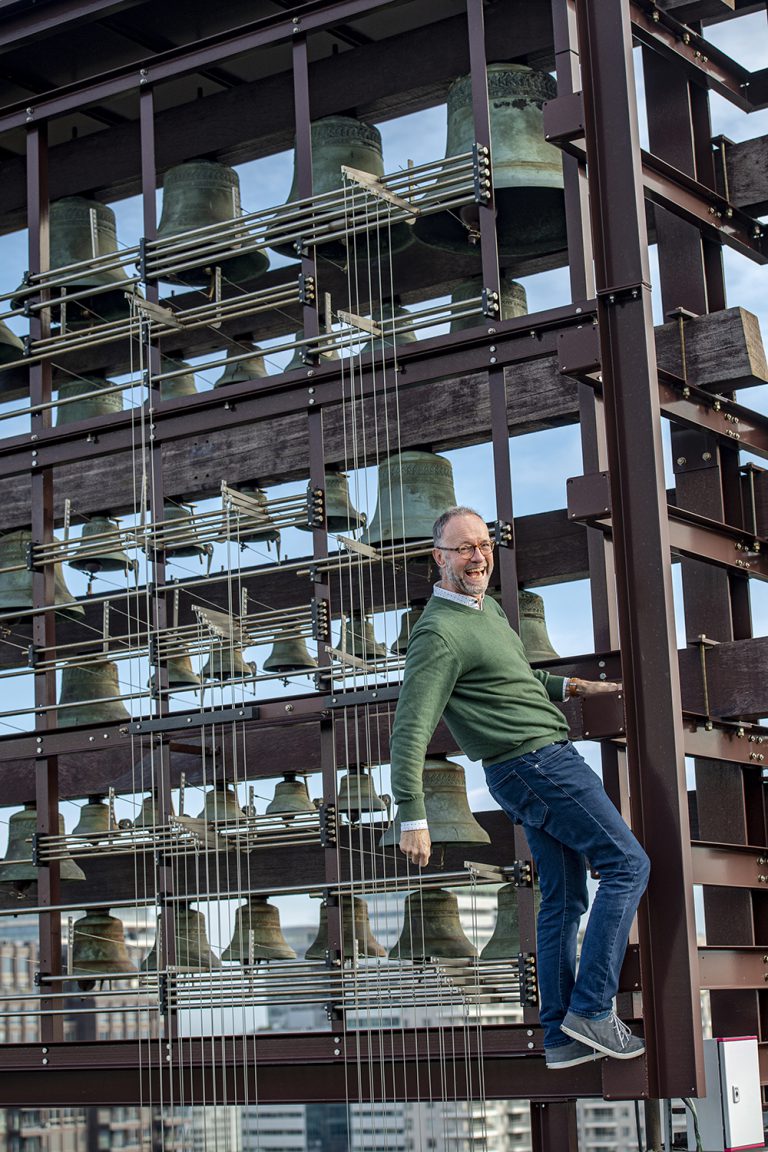Every Monday morning, your music opens the academic week. Don’t you feel sad that no one ever sees you play? “It’s strange that I’m giving my all and I know that so many people hear me, but I can still walk through the main building anonymously after 10 o’clock. It’s actually the opposite of performing on a stage. Fortunately, I often receive enthusiastic responses when people know I’m the carillonneur. ‘Ah, so you are responsible for the cheerful music that I hear when I walk from the station to VU!’ I’m satisfied when people enter the building with a smile.”
You’ve been doing this since 2011. Do you ever dread those early Monday mornings? “It is indeed quite early, but coffee helps. Making music is my life, it never disappoints. It’s always wonderful to play with sound; it’s physical and at the same time your brain is engaged. Music is under so much pressure in our culture. I love live music, music that is created in the moment.”
Henk Verhoef
62
After studying organ, choral conducting and carillon in Amsterdam, Paris and Amersfoort, Verhoef went on to write articles and books, particularly on sounding heritage as well as teach masterclasses in interpretation and improvisation. He also advises on the construction, maintenance and restoration of organs, chime bells and carillons. Besides his current work as an organist and carillonneur, he is the leader of the vocal ensemble Camerata Oude Kerk.
How do you decide what music VU will hear? “I have a bookshelf full of sheet music and I select appropriate music a day in advance. It’s always a variety of music, so it doesn’t get boring. Sometimes I respond to current events. For example, I played the Ukrainian national anthem after the invasion of the country. My main requirement is that people should recognize it as music, that it is pleasant to the ear.”
Do you have favorites? “Many composers from the 16th, 17th, and 18th centuries are fantastic. Haydn, Mozart, and Bach, to name a few. It’s excellent music that can be adapted well for the bells. More challenging are composers like Chopin, Liszt, and Dvořák. A string or pipe has a fixed structure of tones and overtones. The tones in a bell are organized differently, sometimes making the minor third [a certain interval between two tones, Ed.] quite dominant.”
How difficult is it to get a permanent position as a carillonneur or organist? “It’s a fairly small world, everyone knows each other. And that’s also the disadvantage, there is a limited amount of work and you quickly become each other’s competition. So one has to work on their connections and hope that people think of them when a position becomes available. That’s how it went with VU: I was asked for this. Back then, I already knew VU’s organ and carillon quite well from my education.”
Are the university’s organ and carillon so special? “The organ certainly is. It’s fifty years old but built in the style of 18th-century France. That’s a unique style with a unique sound. You couldn’t hear it anywhere in the Netherlands at that time. And as a carillonneur, you know there are bells here. It’s not unusual for a university to have a carillon, by the way – Rotterdam, Twente, and Groningen also have one. In the United States, it’s very common; almost every university there has a carillon.”
VU’s organ and carillon
The 3 octave carillon on the roof of the main building was a gift from the Van Coeverden Adriani Foundation. It was mounted on the roof in 1973 using a special construction. The organ in the Aula is from the same year and was built in the style of the French Baroque. The fiftieth anniversary of the organ was recently celebrated on October 26, 27, and 28 with a special festival. Bernard Winsemius played the carillon until 2011, Henk Verhoef succeeded him.
At VU, you play the carillon once a week and the organ at ceremonies in the Aula. Is that a full-time job? “I’m also the regular organist of the Nieuwe Kerk on Dam Square, the Acropolis for organists. It’s the most special 17th-century organ in the world. And I play the carillon in Monnickendam every Saturday morning, which is internationally the oldest playable carillon. Currently, as a sounding heritage advisor, I’m involved in the restoration of lute bells in the cathedral of Antwerp. Combined with teaching, writing and other smaller roles, it’s a full-time job.”
